
 |
The days are getting shorter and the nights are getting longer, gone are the days of hot solar heating, inland thunderstorms and noctilucent clouds, we are now entering the transition stage between late Summer and early Autumn. The increased darkness opens up a new window of opportunity for astronomical observation and night sky shoots so I was eager to get in my first proper night shoot of the new season. We are also entering another exciting period called solar maximum due to peak sometime within the next four or five years. The sun goes through an eleven year cycle called the sunspot cycle which has a minimum and a maximum. Minimum tends to be a period with few or even any sunspot groups at all and active regions, solar flares and CMEs tend to be less common and as a result there's a far less chance of catching the aurora borealis from mid northern latitudes, in fact, most activity is the result of solar wind streams and CIR regions, any auroras from these tend to be weak with few exceptions. We have been living in the quiescent period of solar minimum for years with such little geomagnetic action that even the sighting of a faint green band would be a welcomed sight.
Solar maximum is what us aurora hunters have been waiting for, during these violent years the Sun can unleash X-class flares and numerous fast moving CMEs which can result in the best aurora displays one might witness in a life time, in fact, the finest auroras I have ever seen manifested during this period in 2000, 2002 and 2003, some of these displays I now consider the stuff of legend as I haven't witnessed anything of that caliber since. However things have now changed and the sun itself is in its own transition phase, we are no entering the early phase of a new solar maximum, this period is called solar cycle 25. This year the sun has woken from its slumber and has been surprisingly active, new cycle sunspots had suddenly appeared from which C-class flares had been erupting and with it came the first small chances of low end aurora activity.
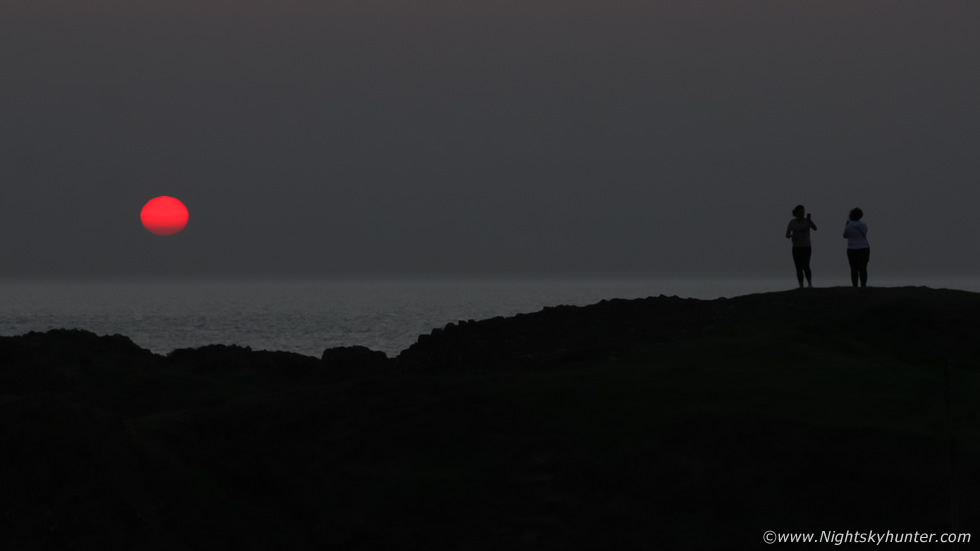 |
August 27th was forecast to be clear and a night photo shoot was arranged at the north coast where I would meet John Fagan, Colleen Webb and Glenn Miles, the plan was simple, shoot the sunset, do a random night sky shoot and maybe with a tremendous amount of luck we might pick up a faint aurora on camera. John Fagan and I met first and tried our luck on the high ground of Ballintoy Harbour, thanks to high humidity the sky was extremely hazy due to weeks of high pressure and as a result we could observe the solar disk with the naked eye, a beautiful sunset was shaping up so we grabbed the DSLRs and telephoto lenses and began shooting. The disk slowly sank into a dense wall of haze and changed colours from yellow to pink then red as it lowered into the invisible ocean haze.
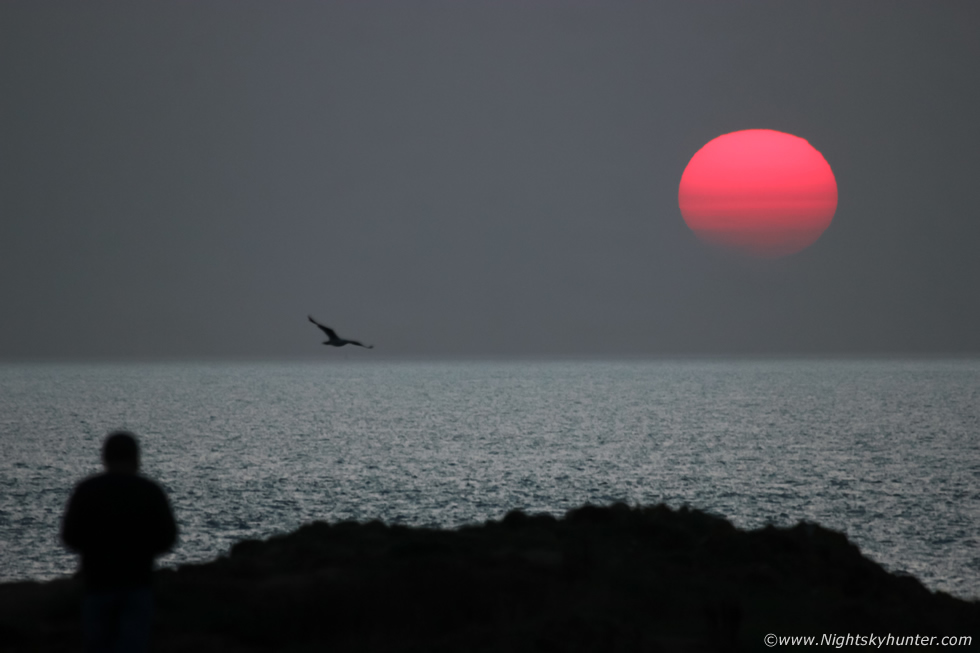 |
The large pink disk, slightly distorted by atmospheric turbulence, looked like an alien sun as seen from another planet. When we zoomed into the disk on our LCD screens we could see two active regions with sunspots north and south of the solar equator, the southern group was larger and had been responsible for the C-class flares, in fact, there was a very slight chance we could have a glancing blow from a faint slow moving CME so this became our first aurora watch of the year. We re-located to Ballintoy church and teamed up with Colleen and Glenn and shot a time lapse of the stars over the church, then amazingly we detected purple beams on camera among the haze, we could just about discern them with the naked eye as ghostly vertical forms which formed and vanished among the dense ocean mist, but we had succeeded, this was our first aurora of the season, sure it was faint and barely worth mentioning but it was a real treat to all of us, it felt like the long wait had been over and now a portal to the world of future geomagnetic storms had been opened. I won't post the image here as it isn't worth the web space however little did I know that a better show would arrive soon taking us completely by surprise.
September 17th looked to have a slight risk of aurora potential, thanks to more sunspot groups and flares our chances of seeing action seemed to be increasing rather quickly. There had already been numerous CMEs all week but every single one of them missed Earth, until the latest from an M-class flare which looked to be coming our way. There was much uncertainty about this CME from spaceweather.com who expected it to be either a glancing blow or miss altogether so there wasn't a great deal of excitement, it just seemed like yet another CME was going to miss us. That morning spaceweather had the headline 'CME hits but weak impact', according to the experts the CME was so weak it didn't generate any significant enhancement to the geomagnetic background, the Bz did drop to -3 then slowly began to move back north during daylight hours so it looked to have been a damp squib. However I couldn't shake the feeling the show wasn't over, I was chatting with the guys that day and despite the odds being stacked against us we considered the possibility that the Bz could drop south again after dark or perhaps the magnetic field would snap back generating new activity so we decided to take a chance and head to the north coast to see what happened.
I left home early, I wanted to get to the coast for sunset as I had drone filming I wanted to do, the forecast was calm, mild, dry, clear skies and that haze which affected our last shoot would be gone thanks to recent rain clearing out the air. The moon would be visible soon after sunset and would be a bright phase at two days before full however due to the angle of the ecliptic the moon would be low in the sky and wouldn't be too bright and the moonlight would be more contrasty.
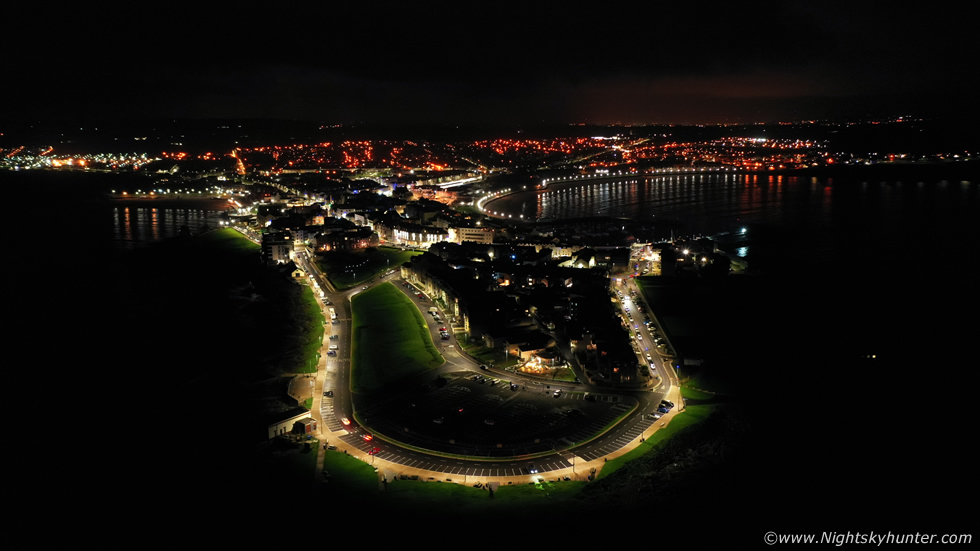 |
As darkness fell I met Nigel McFarland and Colleen Webb and together we did aerial filming of Portrush at night, something I hadn't done in a very long time. Due the size and weight of my drone I couldn't get too close to what is classified as a congested area so I had to stay back and hover over the sea to get the shots I wanted, however the distance worked out perfectly and I got the scenes I wanted. These two images were taken with the Mavic 2 Pro at ISO800, F/2.8 for 1/40th second, as always I was blown away by the quality and low light performance from the 1 inch sensor on this amazing drone. This is the Ramore Head area of Portrush, the area jutting out to the right is the harbour.
 |
I loved the view of the lights against the pitch black ocean and sky, I also recorded video footage and had to admit it gave me quite a buzz. My phone began to ring, it was John Fagan reporting that the Bz was -12, we all looked at each other in astonishment, none of us had expected that, this suddenly raised the ante, this now went from a casual moonlit night shoot and aurora watch to a full-on aurora shoot, if the Bz was -12 we really should be seeing aurora anytime soon, those were good stats. We landed our drones and as our dark adaption kicked in we could see that the northern sky didn't look normal, there was what looked like a glowing milky haze, I said that's an aurora, within a few minutes we were 100% certain of it. We rushed back to the vehicles and agreed to stop along the coast road outside Portrush on the lay bay over looking the ocean for a look before moving on, we never moved for half an hour as were suddenly rooted to the spot for in front of us was the best aurora display we had seen in four years.
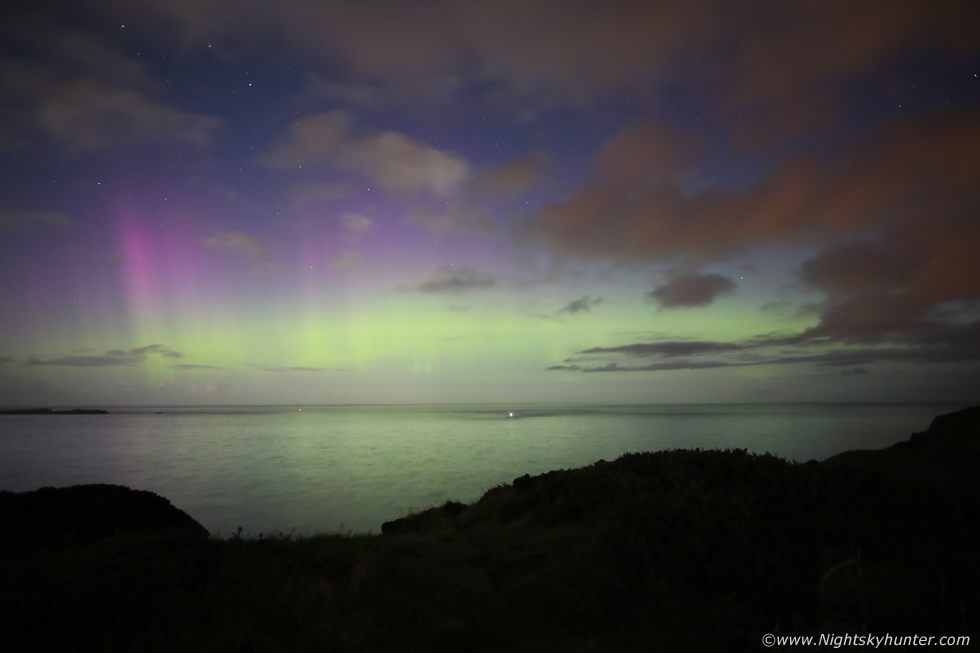 |
The sky was still a blend between advanced twilight and astronomical darkness and yet there was a vivid naked eye aurora in full splendor, we were actually blown away as this completely exceeded any of our expectations. This was only meant to be a quick stop to check the sky, our intentions were to drive on to another part of the coast to get better foreground but we now couldn't move, auroras can fade fast so when they do put on a show the best course of action is to shoot them from where ever you are so this is what we did, we where literally standing in a lay by on the side of the road, I had the camera and tripod on the other side of the guard rail on spongy grass to get my first exposures.
I was shooting with the Canon 5D Mark IV full frame with 15mm Irix lens, this would be my first time shooting with full frame on a proper aurora. I took a few test exposures but my intention was to shoot a time lapse soon so I decided to go big and use a very high ISO so I could get away with a shorter exposure and hence get more frames. I stopped the 15mm F/2.4 lens down to F/3.5, selected ISO5000 and a shutter of 6 sec's, just as I found this sweet spot the aurora seemed to come alive as the sky darkened. With the naked eye we could see a huge green arc covering the entire ocean horizon from NW to NE at least 100 degrees in length, the arc was located high in the sky with a vacant region of auroraless sky with stars between the base and the horizon, a visual cue that this display was of a respectable caliber. Then without warning an array of vertical beams erupted upward from the arc piercing through Canes Venatici and Ursa Major, we were all yelling with delight and quite a few curse words went up into the sky, cursing with joy and wonder at the spectacle, the beams were green with the naked eye and we could also see red hues at the upper extremities while the camera picked up purple and pink contrasting beautifully against the moonlit circumpolar sky. This was my first image of a decent aurora with a full frame camera at super wide angle.
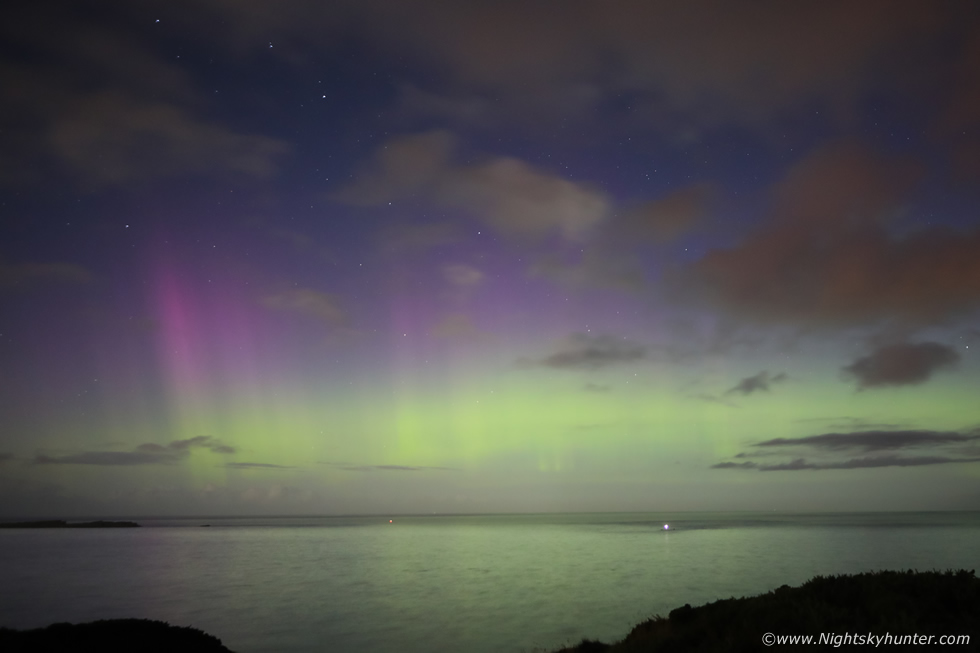 |
Another image cropped in a little closer, using my extended hand I measured the beams at +40 degrees high or 80 apparent full moon diameters as the red tips reached Dubhe in Uma.
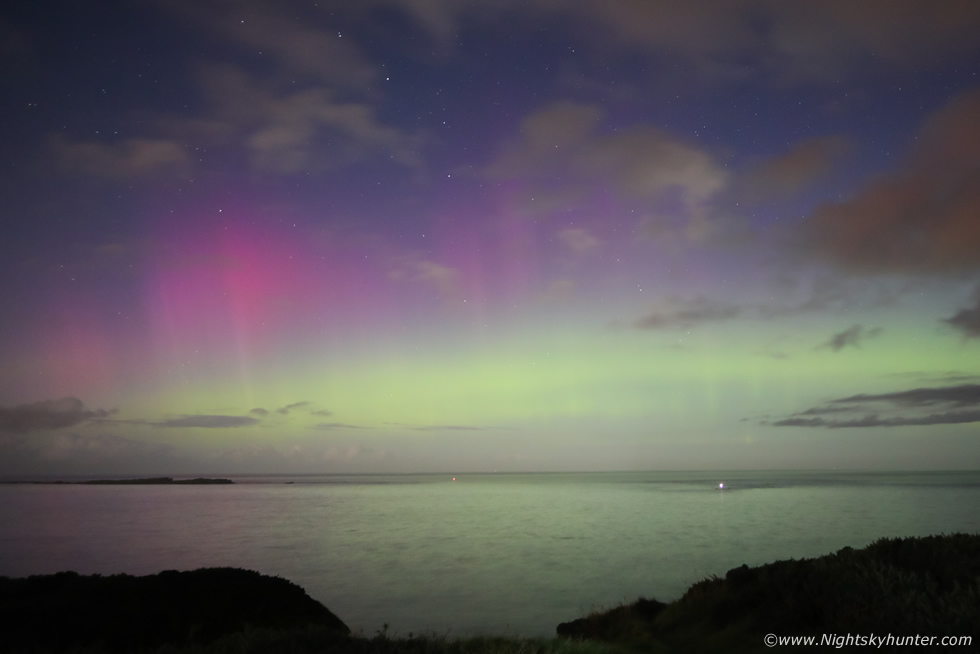 |
We could see all these colours easily with the naked eye and now we could see twin tiers with both arcs overlapping one another, it was amazing how well this display stood out visually even with a waxing gibbous moon behind us. Colleen was beside herself with excitement, this was her first decent aurora and she was beside herself with joy combined with that rush and panic to get the correct camera settings to document the show. The beams began to wane somewhat so we decided to quickly change location, we didn't have time to travel far so Nigel suggested the newly revamped Magheracross car park on high ground which overlooked the ocean, so we packed up and drove the 200 or so meters and pulled into the car park and made our way over to the far side.
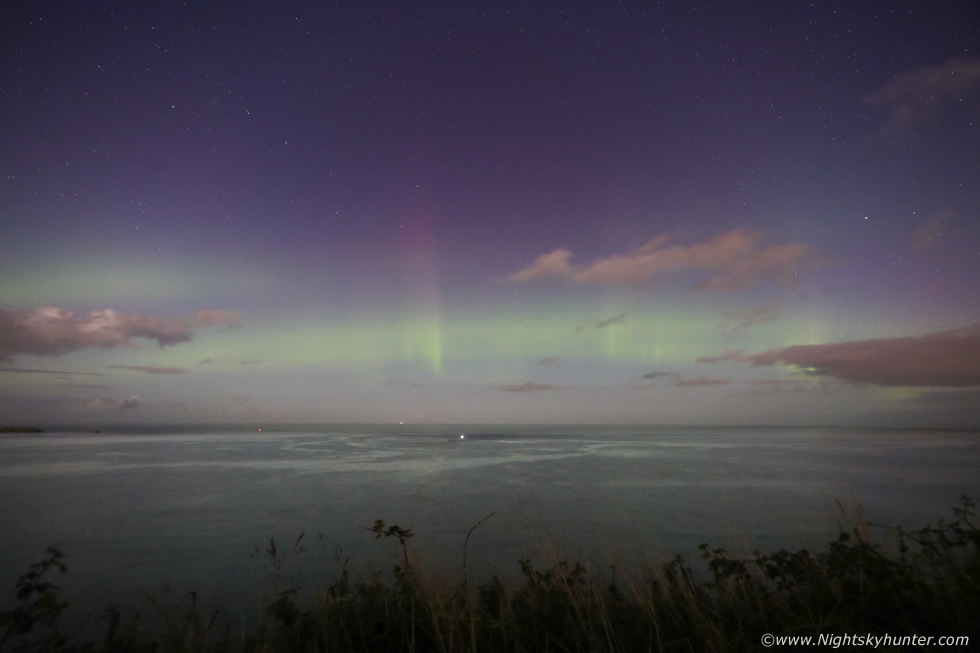 |
The aurora morphed between two tiers and staggered sections of a third tier with sporadic episodes of beams, first to the NW, then N then NE, we could see them slowly dancing from left to right, we felt confident that we were witnessing a solid G2 geomagnetic storm.
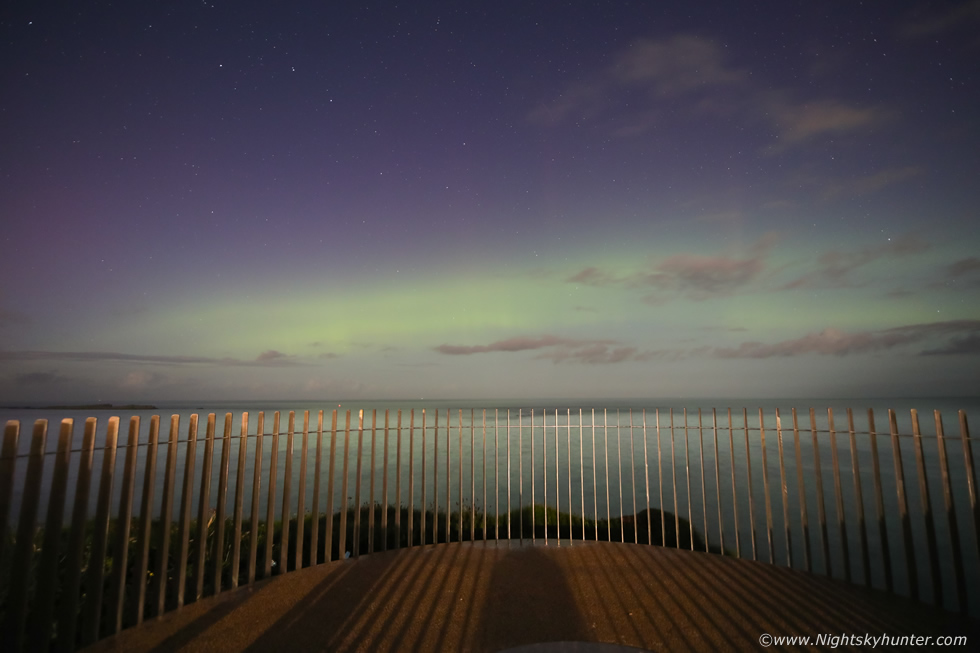 |
Magheracross has two new viewing platforms, Colleen and Nigel positioned in the first while I ventured over to the eastern-most platform, I had to capture the view with the aurora just for the record, I really should have stood in this image looking over the rails. I then set up the 5D on the grass to get as little clutter as possible and began shooting a time lapse.
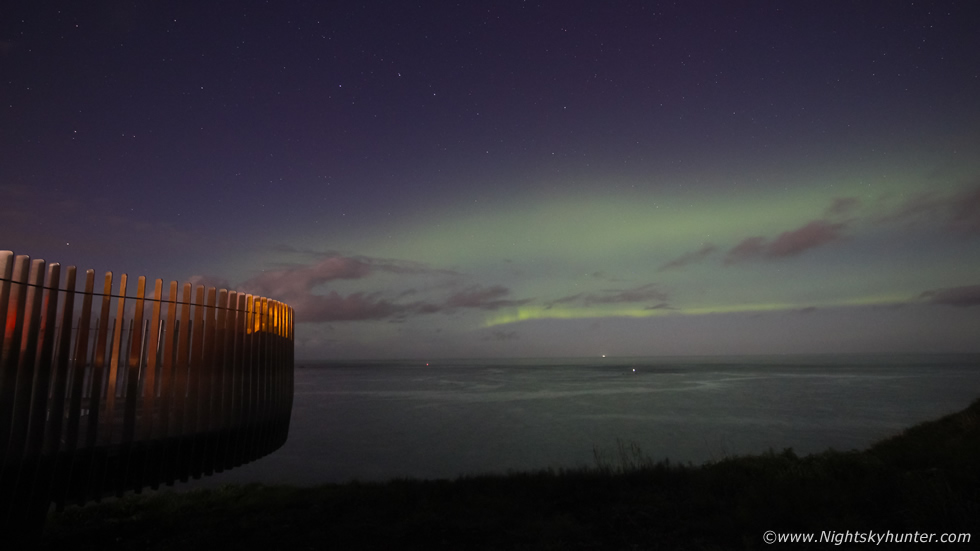 |
Using the Canon 600D crop sensor with 10mm F/2.8 lens at ISO1600 and 13 sec exposures I began another time lapse with the viewing point on the left hand side, this was the only foreground I had to work with. You can see a new arc or band above the horizon, to the naked eye this looked like an intense green bar of light so straight it was like the edge of a ruler.
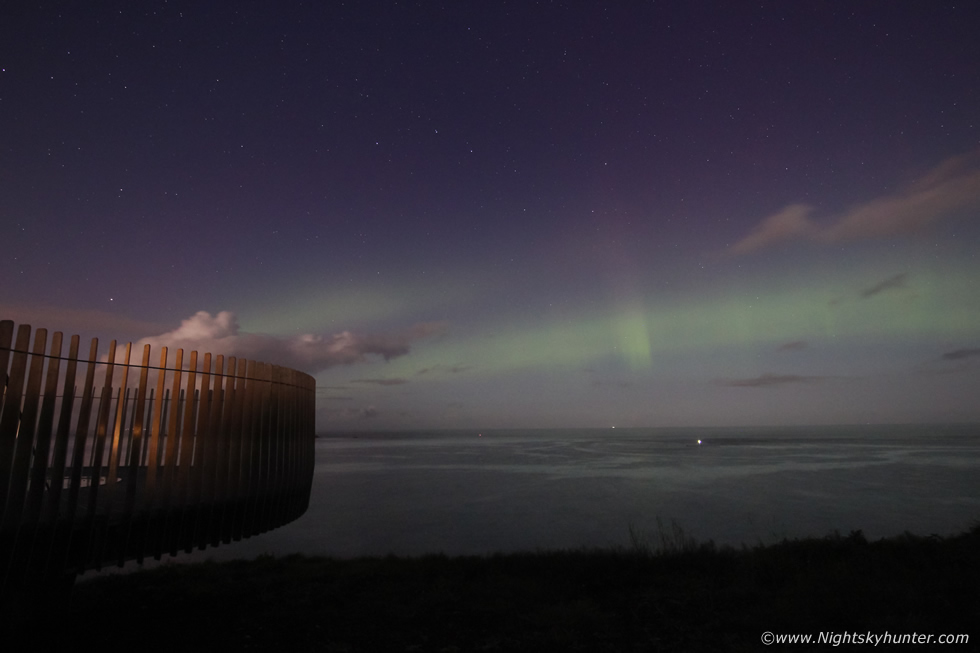 |
Two tiers with beams, at this stage a couple of other photographers turned up including a couple who ventured onto the viewing platform where Nigel helped them get the correct camera settings including selfies of each other with the aurora which was a very nice moment. I heard a car pulling in and stopping, then lights off and engine off, all I heard was ''beams'', I knew the voice, it was John Fagan who had just arrived from Dungannon. He later explained when he saw the beams he was so shocked and blown away that he just wanted to enjoy the visual scene so he spent a good 15-20 min's taking it all in for the memories, he explained later that the experience had really moved him.
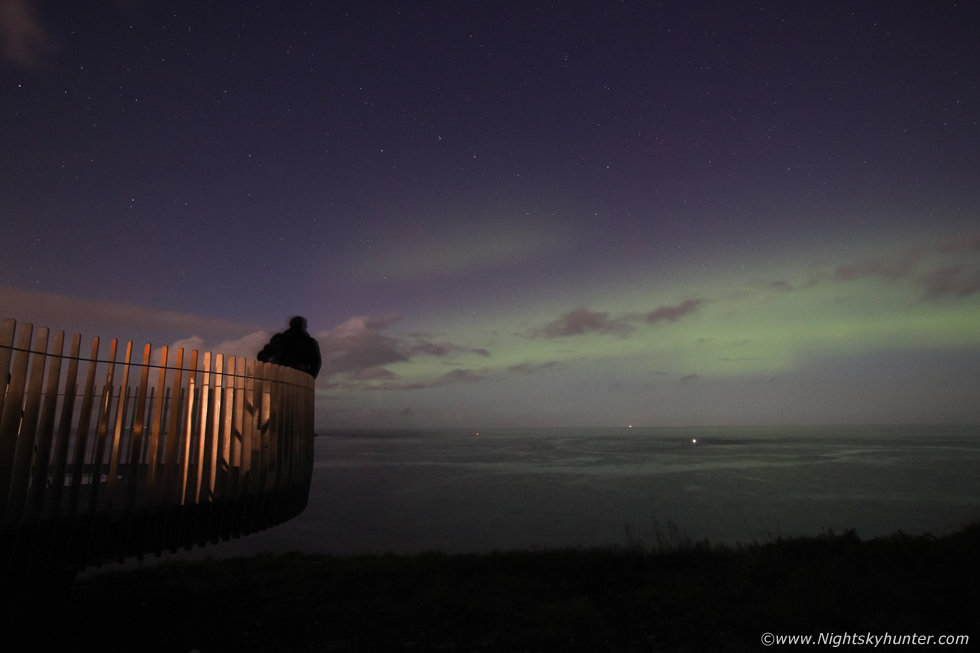 |
The couple posing for an image which by chance I happened to capture during the course of my time lapse, and in the sky was that elusive segment of a third tier. After 23.00 the Bz began moving north and as a result the aurora began to fade and drop in height, this decline in activity bought us some free time to change position and come up with a new plan. Auroras are unpredictable, they can vanish completely then return with renewed vigor a few hours later, especially so around magnetic midnight. We had got our images of the display at its best now we just needed foreground, after a quick meeting in the dark we all decided on Ballintoy so we jumped into our cars and vans and all three vehicles made their way through the coastal route at night driving with intent.
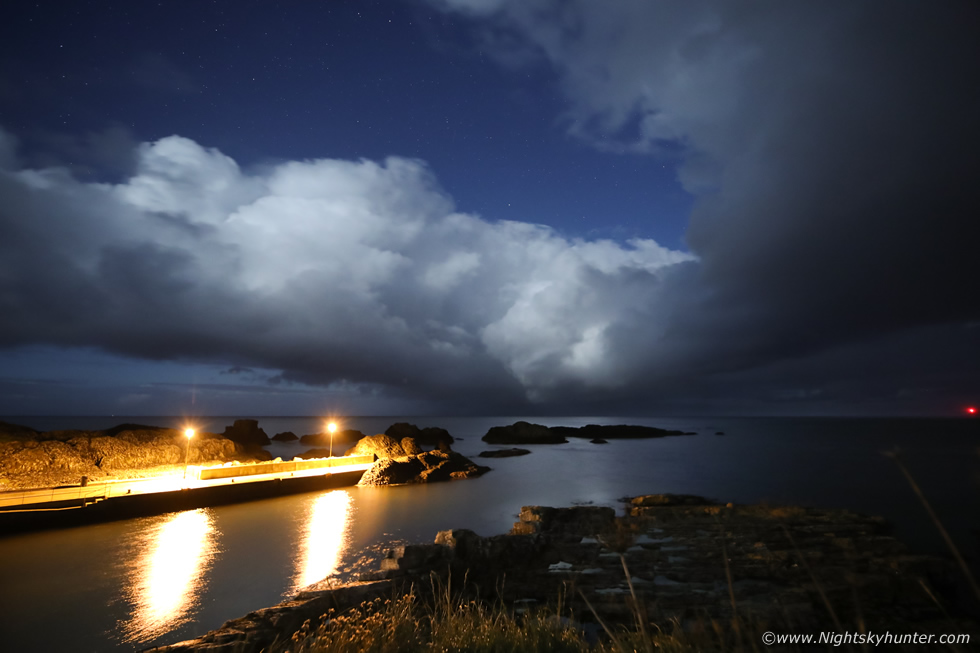 |
We arrived at Ballintoy and grabbed all the gear then suddenly the sky clouded over and at the same time the Bz went +5 north meaning the show was almost over, it looked like our night had come to an end. However we remained in place just in case, radar indicated a cell over the sea near our position and after almost an hour waiting the cell began to clear to the north, then the moon broke free from clouds and lit up a nice line of convection over the ocean. The towering cumulus were low topped but quite solid and very beautiful in the moonlight with stars aloft so I had to get an image. This was shot in tungsten with 6 sec exposure at 15mm wide angle at ISO500, the red light to the right is from a light house on Rathlin Island.
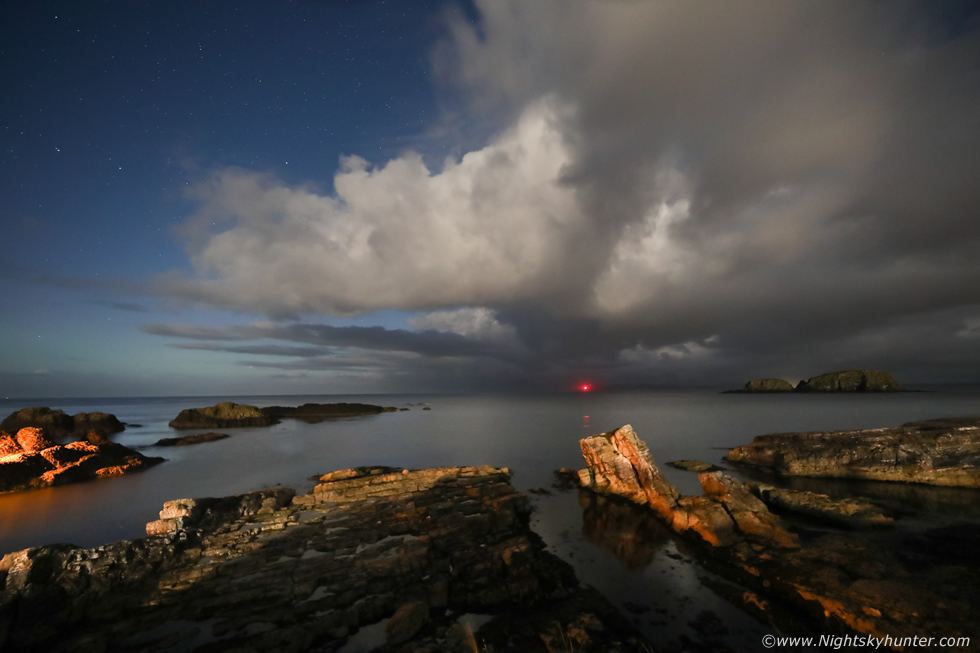 |
A little later as the cell moved away over the ocean towards Scotland with cumulus at the rear, the moonlight lit up the stacks very well. In the clear sky to the left you can still see the green glow from the aurora below Ursa Major. At 01.30 we called it a night and I began the long drive home back to Cookstown. It was a dead calm quiet night with little traffic on the road, periodically dense banks of mist would cover the road then clear again, I was making good progress despite feeling very tired, at this stage of the night I just wanted to get home and to bed.
Suddenly outside Garvagh on a dark and quiet stretch of road my headlights picked out a herd of dairy cows rite in the middle of the road straight in front of me!, I only had a few seconds to react so I slammed on the breaks and came to a stop no more than two meters from the nearest cow. The sight was surreal, a dozen cows casually walking across a main road in pitch darkness, finally they cleared through and I was on my way again, I let out a sigh of relief, that had been a very close call indeed. Had I not been concentrating or had that section of road been covered in mist I could have drove straight into the herd at full speed, that would have been tragic for both the cows and myself. It just goes to show that one must remain alert at night even when the roads seem devoid of life.
Drone footage showing the lights of Portrush and Ramore Head at night captured using auto mode on the Mavic 2 Pro at high ISO, the footage is straight off the drone with no editing.
Full time lapse of the Magheracross G2 aurora display captured with both crop sensor and full frame bodies and wide angle fast lenses. We were all pleasantly surprised by this night which once again goes to show just how unpredictable the northern lights can be and how accurate forecasting of any display can be rather fruitless and how even a weak CME can put on a good show, and how it always comes down to the southern tilt of the Bz component. As solar cycle 25 advances I expect bigger and better displays to come in the months and years ahead so keep watching this space as I promise you the best has yet to come. Thanks very much for reading.
Martin McKenna